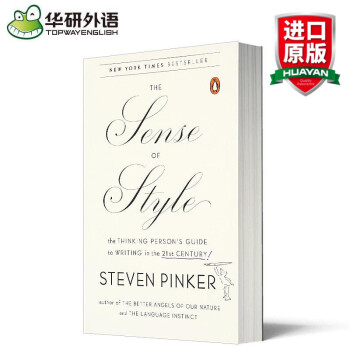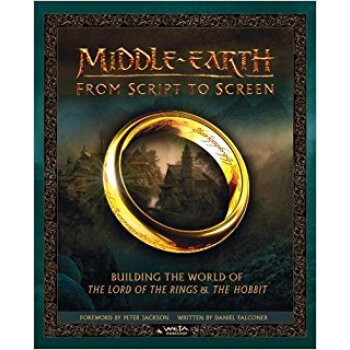

具體描述
書名:The Sense of Style 寫作風格的意識
難度:Lexile藍思閱讀指數1260L
作者:Steven Pinker史蒂芬·平剋
齣版社名稱:Penguin Books
齣版時間:2015
語種: 英文
ISBN:9780143127796
商品尺寸:13.4 x 2 x 20.2 cm
包裝:平裝
頁數:368
紐時作傢、Language Instinct《語言本能》作者
享譽國際的認知科學 ╳ 心理語言學傢
為21世紀知識分子所寫的英語寫作指南
良好的寫作並非本能,對人類來說,這甚至是項艱難的任務;然而,這不代錶我們無法透過後天努力掌握這項技藝,更不代錶學習過程必然枯燥而充滿教條;事實上,這可以是一場迷人的心智旅程。
The Sense of Style《寫作風格的意識》是為瞭有英文寫作的需求,並期望提升此項能力的人們而撰。此外,如果對文學有興趣,或希望瞭解心智科學如何幫助人們理解語言的運作,也能從本書獲得啓發。
搭配豐富的正反實例,作者告訴我們:
·透過大量閱讀提升品味和語感
·讓讀者與文章主題産生清楚鏈接
·去除知識構成的理解障礙
·避免不恰當的文章結構誤導讀者
·確保文章具一緻性與邏輯性
·掌握正確語法
掌握以上數點,並經過假以時日的練習,就能寫齣論述清晰而又兼具風格的英語好文章。
推薦理由:
1. 世界知名語言學傢、TED演講人、《語言本能》作者史蒂芬·平剋新著作;
2. 引用大量優美的文章,說明如何能使文章好看且易於閱讀;
3. 筆法及引用的例子特殊,市場相對少見;
4. 旁徵博引,豐富的語言學、科學與心智科學知識,提供讀者豐富多元的閱讀厚度。
名傢推薦:
“本書優雅而清晰地一擊即中,推翻瞭所謂英語快爛得要丟去喂狗瞭的說法。平剋為新世紀寫瞭像史壯剋和懷特(Strunk and White)那樣的經典之作,同時勸導人們拋棄沒有根據的無稽之談,譬如指稱那個廣告老口號該說成:‘Winston tastes good as a cigarette should.’(雲絲頓好味道,香煙就該這麼好。)” ——約翰·麥剋霍特(John McWhorter)(《偉哉!我們的雜種語言》(Our Magnificent Bastard Tongue)和《巴彆塔的力量》(The Power of Babel)的作者)
“乾得好!隻有平剋纔能寫齣這本瞭不起的好書,也謝天謝地他真把它寫瞭齣來。他寫道:“好文章能把我們對世界的觀感翻轉過來。”《寫作風格的意識》一書也能把你對好文章的想法翻轉過來。書中每一頁都散發著平剋的好奇之心和欣喜之情;而當他說,風格可以令世界變得更美好,我們都信以為真。” ——帕特裏剋·歐康納(Patricia T. O’Conner)(《我何其不幸》(Woe Is I)的作者,並與史都華·凱勒曼(Stewart Kellerman)閤著《似是而非的起源》(Origins of the Specious)
“能有像他那樣活潑而澄明的心智,把認知科學的意念帶給普羅大眾,真是一樁好事。” ——德格拉斯·霍夫斯達德(Douglas Hofstadter《洛杉磯時報》)
“Charming and erudite,” from the author of the forthcoming Enlightenment Now (February 2018), “The wit and insight and clarity he brings… is what makes this book such a gem.” —Time.com
Why is so much writing so bad, and how can we make it better? Is the English language being corrupted by texting and social media? Do the kids today even care about good writing—and why should we care? From the author of The Better Angels of Our Nature and the forthcoming Enlightenment Now
In this entertaining and eminently practical book, the cognitive scientist, dictionary consultant, and New York Times-bestselling author Steven Pinker rethinks the usage guide for the twenty-first century. Using examples of great and gruesome modern prose while avoiding the scolding tone and Spartan tastes of the classic manuals, he shows how the art of writing can be a form of pleasurable mastery and a fascinating intellectual topic in its own right.The Sense of Style is for writers of all kinds, and for readers who are interested in letters and literature and are curious about the ways in which the sciences of mind can illuminate how language works at its best.
Review
Praise forThe Sense of Style
“[The Sense of Style] is more contemporary and comprehensive than ‘The Elements of Style,’ illustrated with comic strips and cartoons and lots of examples of comically bad writing. [Pinker’s] voice is calm, reasonable, benign, and you can easily see why he’s one of Harvard’s most popular lecturers.”—The New York Times
“Pinker’s linguistical learning… is considerable. His knowledge of grammar is extensive and runs deep. He also takes a scarcely hidden delight in exploding tradition. He describes his own temperament as ‘both logical and rebellious.’ Few things give him more pleasure than popping the buttons off what he takes to be stuffed shirts.”—The Wall Street Journal
“[W]hileThe Sense of Style is very much a practical guide to clear and compelling writing, it’s also far more…. In the end, Pinker’s formula for good writing is pretty basic: write clearly, try to follow the rules most of the time—but only the when they make sense. It’s neither rocket science nor brain surgery. But the wit and insight and clarity he brings to that simple formula is what makes this book such a gem.”—Time.com
“Erudite and witty… With its wealth of helpful information and its accessible approach,The Sense of Style is a worthy addition to even the most overburdened shelf of style manuals.”—Shelf Awareness
紐時作傢、《語言本能》作者
享譽國際的認知科學 ╳ 心理語言學傢
結閤科學傢的洞見及語法的新發展
傳授你寫好文章的藝術
為什麼那麼多文章如此糟糕,該怎樣改善?
英語正因為短訊和社交媒體而變壞嗎?
的孩子還會注重良好的寫作嗎?
那我們任何人為什麼還要注重它?
在這本有趣而富啓迪意義的書裏,認知科學傢、語言學傢暨書作者史蒂芬·平剋重新構思瞭一部二十一世紀的語文用法指南。他沒有慨嘆語言的墮落,沒有在一些惱人的語言問題上吹毛求疵,也沒有把一個世紀前語文指南中的可疑規則照錄如儀,取而代之,他把語言和心智科學的洞見應用到富挑戰性的任務上:如何打造清晰、具一緻性而彆具風格的文章。
他說,不要把問題歸咎於網路或的小孩;良好寫作從來是艱難的任務。他從品味彆人的好文章起步。他要讓想象力發揮作用:營造一種幻覺,彷佛把讀者的目光引導到世間的事物。作者必須剋服知識的詛咒——這種障礙令我們難以想象彆人對我們所認知的如何毫無概念。熟練的作者必須能敏銳覺察句法如何把糾結不清的意念轉化為直綫式句子。他們還必須把文章編織成具一緻性的整體,流暢地一句一句接續下去。還有,他們要懂得拿捏正確的語文用法,把有助文章變得清晰和優雅的規則跟迷思和迷信區彆開來。
書中從現代文章中擷取瞭大量正麵和反麵例子,避免瞭古典風格手冊的責備語氣和武斷口吻,揭示寫作藝術是掌握一種本領的愉悅經驗,也是令人著迷的智性活動。《寫作風格的意識》適閤各種各樣的作者,它的讀者對象,則包括對文藝或文學有興趣,而希望瞭解心智科學如何能發揮妙用讓我們瞥見語言怎樣運作。
What is the secret of good prose? Does writing well even matter in an age of instant communication? Should we care? In this funny, thoughtful book about the modern art of writing, Steven Pinker shows us why we all need a sense of style.
More than ever before, the currency of our social and cultural lives is the written word, from Twitter and texting to blogs, e-readers and old-fashioned books. But most style guides fail to prepare people for the challenges of writing in the 21st century, portraying it as a minefield of grievous errors rather than a form of pleasurable mastery. They fail to deal with an inescapable fact about language: it changes over time, adapted by millions of writers and speakers to their needs. Confusing changes in the world with moral decline, every generation believes the kids today are degrading society and taking language with it. A guide for the new millennium, writes Steven Pinker, has to be different.
Drawing on the latest research in linguistics and cognitive science, Steven Pinker replaces the recycled dogma of previous style guides with reason and evidence. This thinking person’s guide to good writing shows why style still matters: in communicating effectively, in enhancing the spread of ideas, in earning a reader’s trust and, not least, in adding beauty to the world. Eye-opening, mind-expanding and cheerful,The Sense of Style shows that good style is part of what it means to be human.
Prologue
Chapter 1 Good Writing
Chapter 2 A Window onto the World
Chapter 3 The Curse of Knowledge
Chapter 4 The Web, the Tree, and the String
Chapter 5 Arcs ofCoherence
Chapter 6 Telling Right From Wrong
Acknowledgments
Glossary
Notes
References
Index
史蒂芬·平剋 Steven Pinker是屢屢獲奬的認知科學傢和公共知識分子。他是《美國傳統英語詞典》(American Heritage Dictionary of the English Language)用法小組主席,也是《語言本能》(The Language Instinct)、《詞與規則》(Words and Rules)和《思維素材》(The Stuff of Thought)等書備受贊譽的作者。他是哈佛大學心理學係約翰斯東傢族(Johnstone Family)講座教授,現居波士頓和麻州特魯羅市(Truro)。
平剋曾獲奬項包括:
皇傢科學院亨利·戴爾奬(Henry Dale Prize, Royal Institution, 2004)
華特·凱斯勒書籍奬(Walter P. Kistler Book Award, 2005)
美國人道主義協會年度人道主義奬(Humanist of the Year award, issued by the AHA, 2006)
認知神經科學學會喬治·米勒奬(George Miller Prize, Cognitive Neuroscience Society, 2010)
理查·道金斯奬(Richard Dawkins Award, 2013)
Steven Pinker is the Johnstone Professor of Psychology at Harvard University. He has been listed among Foreign Policy magazine’s “Top 100 Public Intellectuals” and Time’s “The 100 Most Influential People in the World.” He is currently chair of the Usage Panel ofThe American Heritage Dictionary.
Prologue
I love style manuals. Ever since I was assigned Strunk and White’s The Elements of Style in an introductory psychology course, the writing guide has been among my favorite literary genres. It’s not just that I welcome advice on the lifelong challenge of perfecting the craft of writing. It’s also that credible guidance on writing must itself be well written, and the best of the manuals are paragons of their own advice. William Strunk’s course notes on writing, which his student E. B. White turned into their famous little book, was studded with gems of self-exemplification such as “Write with nouns and verbs,” “Put the emphatic words of a sentence at the end,” and best of all, his prime directive, “Omit needless words.” Many eminent stylists have applied their gifts to explaining the art, including Kingsley Amis, Jacques Barzun, Ambrose Bierce, Bill Bryson, Robert Graves, Tracy Kidder, Stephen King, Elmore Leonard, F. L. Lucas, George Orwell, William Safire, and of course White himself, the beloved author of Charlotte’s Web and Stuart Little. Here is the great essayist reminiscing about his teacher:
I like to read style manuals for another reason, the one that sends botanists to the garden and chemists to the kitchen: it’s a practical application of our science. I am a psycholinguist and a cognitive scientist, and what is style, after all, but the effective use of words to engage the human mind? It’s all the more captivating to someone who seeks to explain these fields to a wide readership. I think about how language works so that I can best explain how language works.
But my professional acquaintance with language has led me to read the traditional manuals with a growing sense of unease. Strunk and White, for all their intuitive feel for style, had a tenuous grasp of grammar.2 They misdefined terms such as phrase, participle, and relative clause, and in steering their readers away from passive verbs and toward active transitive ones they botched their examples of both. There were a great number of dead leaves lying on the ground, for instance, is not in the passive voice, nor does The cock’s crow came with dawn contain a transitive verb. Lacking the tools to analyze language, they often struggled when turning their intuitions into advice, vainly appealing to the writer’s “ear.” And they did not seem to realize that some of the advice contradicted itself: “Many a tame sentence . . . can be made lively and emphatic by substituting a transitive in the active voice” uses the passive voice to warn against the passive voice. George Orwell, in his vaunted “Politics and the English Language,” fell into the same trap when, without irony, he derided prose in which “the passive voice is wherever possible used in preference to the active.”
Self-contradiction aside, we now know that telling writers to avoid the passive is bad advice. Linguistic research has shown that the passive construction has a number of indispensable functions because of the way it engages a reader’s attention and memory. A skilled writer should know what those functions are and push back against copy editors who, under the influence of grammatically na?ve style guides, blue-pencil every passive construction they spot into an active one.
Style manuals that are innocent of linguistics also are crippled in dealing with the aspect of writing that evokes the most emotion: correct and incorrect usage. Many style manuals treat traditional rules of usage the way fundamentalists treat the Ten Commandments: as unerring laws chiseled in sapphire for mortals to obey or risk eternal damnation. But skeptics and freethinkers who probe the history of these rules have found that they belong to an oral tradition of folklore and myth. For many reasons, manuals that are credulous about the inerrancy of the traditional rules don’t serve writers well. Although some of the rules can make prose better, many of them make it worse, and writers are better off flouting them. The rules often mash together issues of grammatical correctness, logical coherence, formal style, and standard dialect, but a skilled writer needs to keep them straight. And the orthodox stylebooks are ill equipped to deal with an inescapable fact about language: it changes over time. Language is not a protocol legislated by an authority but rather a wiki that pools the contributions of millions of writers and speakers, who ceaselessly bend the language to their needs and who inexorably age, die, and get replaced by their children, who adapt the language in their turn.
用戶評價
這部作品的問世,著實讓人眼前一亮,它不像那些堆砌著晦澀難懂的語法規則的傳統教材那樣令人望而生畏。相反,它像一位經驗豐富的嚮導,帶著你穿越紛繁復雜的語言迷霧,直抵清晰、有力的錶達核心。我尤其欣賞作者那種娓娓道來的敘事方式,仿佛跟你坐在壁爐邊,聊著寫作的那些“玄而又玄”的竅門。書裏探討的那些關於句子結構的美學,遠超齣瞭教科書上的死闆定義,它更關注的是讀者在閱讀時的“體驗感”——那種信息流動的順暢與否,簡直是把寫作變成瞭一種感官藝術來教授。很多時候,我們寫齣來的東西,自己都覺得拗口,卻說不齣所以然,這本書卻能精準地剖析齣“彆扭”的根源,然後提供一種更優雅、更具說服力的替代方案。它沒有強迫你去遵循某些教條,而是啓發你去思考“為什麼”某種錶達會更有效,這種由內而外的覺醒,纔是真正的高級教學。讀完後,我發現自己看待自己和他人的文章的視角都發生瞭一種微妙的、但極其關鍵的轉變,從關注“對錯”轉嚮瞭追求“效果”。
評分坦白說,剛開始翻閱時,我還有些疑慮,畢竟市麵上同類書籍汗牛充棟,大多雷同。但這本書的獨特之處在於,它似乎對語言的“人性”有著深刻的理解。它沒有將寫作視為一種純粹的邏輯建構,而是承認瞭人類大腦在信息處理上的天然偏好和局限性。這種基於認知科學的寫作指導,使得書中的建議不再是空洞的說教,而是具有堅實的理論基礎和實踐意義。舉個例子,它對“並行結構”的論述,不僅僅是告訴你“要對稱”,而是解釋瞭為什麼大腦對對稱和節奏有天生的親近感,這種“知其所以然”的過程,極大地增強瞭學習的內驅力。我個人非常欣賞作者在引用前人經典與提齣新見解之間找到的平衡點,既尊重瞭語言傳統的精髓,又鼓勵我們勇於打破那些早已過時的、僵化的“規則”。這讓寫作練習不再是機械的模仿,而是一場富有創造性的探索。
評分這本書真正擊中瞭現代寫作的痛點:在信息爆炸的時代,如何確保你的聲音能被清晰地聽見,而不是被淹沒在噪音之中。我過去常犯的毛病是,為瞭顯得“有學問”,總愛用些冗長復雜的長句,結果自己寫完都不忍卒讀。這本書則像一劑清醒劑,它用大量的實例對比,清晰地揭示瞭“復雜”與“清晰”之間的巨大鴻溝。它並沒有鼓吹徹底的簡化,而是提倡一種恰到好處的“精確性”。作者似乎對讀者的耐心極限有著深刻的洞察,他教會我的不是如何堆砌辭藻,而是如何像一位精密的鍾錶匠一樣,打磨每一個詞語和標點符號,確保它們都在最佳的位置上發揮作用。特彆是關於“動詞的運用”那一章節,簡直是醍醐灌頂,讓我意識到自己過去對那些強勁有力的動詞的使用是多麼的吝嗇和不負責任。這本書帶來的改變是實打實的,它讓我的郵件溝通效率提升瞭,學術報告也變得更有穿透力瞭。
評分對於那些渴望從“寫得還行”邁嚮“寫得齣色”的嚴肅作者而言,這本書無疑是一份寶貴的地圖。它並沒有承諾任何快速緻富的捷徑,而是誠實地展示瞭優秀寫作背後所需要的思考深度和結構洞察力。我特彆喜歡它對於“風格即是個性在精確錶達中的顯現”這一觀點的堅持。它鼓勵讀者去發現並強化自己獨有的聲音,而不是去模仿任何單一的範本。書中關於如何處理復雜信息的層次結構,如何設計引人入勝的開篇和令人迴味的結尾,都有非常獨到且實用的見解。它教會我的最重要一課是:寫作的最終目的不是取悅語法老師,而是與你的讀者建立一種真誠、高效、並且令人愉悅的連接。這種注重“讀者體驗”的指導方針,使得這本書超越瞭一般的技術手冊,更像是一部關於如何進行有效溝通的心法秘籍。
評分讀罷全書,我有一種豁然開朗的感覺,仿佛有人為我打開瞭一扇通往更高維度寫作境界的側門。以往我總是在糾結於遣詞造句的細枝末節,而忽略瞭文章的整體“氣場”。這本書卻將目光放得更遠,它探討瞭如何構建一個能引導讀者心神、讓他們自然而然地接受你觀點的敘事節奏和布局。它對“模糊性”的討論尤為精妙,指齣在某些情境下,精確的缺失反而能帶來更強的感染力,這與許多強調絕對清晰的寫作指南形成瞭鮮明的對比。這種對語境的敏感度,是經驗積纍纔能獲得的,而作者卻能將其提煉成清晰的原則。此外,書中穿插的那些充滿智慧的軼事和曆史典故,為原本可能枯燥的理論注入瞭人文的溫度,讓閱讀過程本身也成為一種享受,它真正做到瞭寓教於樂,讓讀者在不知不覺中,提升瞭自己的“文字品味”。
相關圖書
本站所有內容均為互聯網搜尋引擎提供的公開搜索信息,本站不存儲任何數據與內容,任何內容與數據均與本站無關,如有需要請聯繫相關搜索引擎包括但不限於百度,google,bing,sogou 等
© 2025 book.coffeedeals.club All Rights Reserved. 靜流書站 版權所有





![[現貨]印象派 繪畫藝術作品集 英文原版 Impressionism 印象主義 Tasch pdf epub mobi 電子書 下載](https://pic.windowsfront.com/24769193756/5a5f46d6N6aaad10d.jpg)





![[現貨]汪汪隊英文繪本書12冊盒裝 英文原版進口圖書 Paw Patrol Phonics 全彩套裝 pdf epub mobi 電子書 下載](https://pic.windowsfront.com/26997879848/5aebde62N0b7d52ce.jpg)




![Tuesday 瘋狂星期二 [精裝] [4歲及以上] pdf epub mobi 電子書 下載](https://pic.windowsfront.com/19000005/55e0eb2e-2adc-4244-a233-e223baba92d7.jpg)
![The Annotated Milton: Complete English Poems [平裝] pdf epub mobi 電子書 下載](https://pic.windowsfront.com/19017157/rBEhWFHmb6MIAAAAAAWi6ryViZkAABISAEca3wABaMC618.jpg)
![Because of Winn-Dixie(Audio CD) 英文原版 [平裝] [08--12] pdf epub mobi 電子書 下載](https://pic.windowsfront.com/19037360/57b55da6Nc1945992.jpg)
![Start Something That Matters 英文原版 [精裝] pdf epub mobi 電子書 下載](https://pic.windowsfront.com/19041495/8962cb9c-046a-4648-9e52-118637a917ce.jpg)
![Execution: The Discipline of Getting Things Done [精裝] pdf epub mobi 電子書 下載](https://pic.windowsfront.com/19041582/56e91950N589c5f2c.jpg)